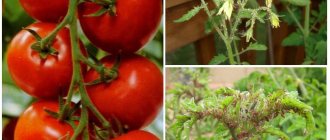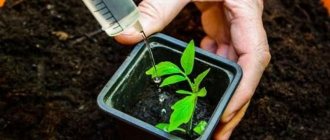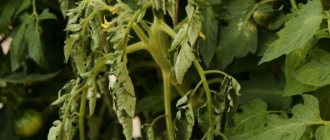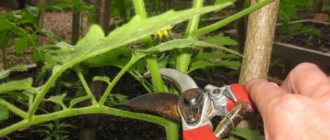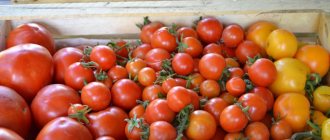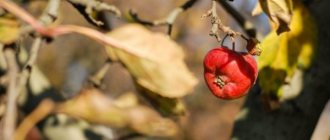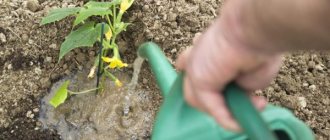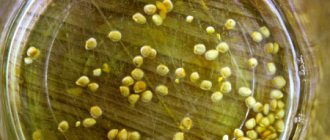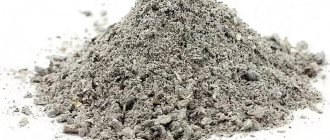Do I need to fertilize flowering tomatoes?
The main reason why you should not neglect feeding at this time is that lack of nutrition can lead to the formation of a large number of barren flowers in the plant .
They will take nutrients from developing fruits, which will lead to a significant reduction in harvest volume.
This can also have a very bad effect on tomato seeds . Seeds of weakened plants germinate poorly, seedlings from them are weak and often get sick.
So if you prefer to grow tomatoes from your own seeds, pay attention to feeding during this period.
How to fertilize tomatoes after planting in the ground, read the material at our link.
Important : Another possible consequence of lack of nutrition during flowering can be sour-tasting tomatoes and hard cores.
Features of watering tomatoes depending on the period of its growth.
Tomato bushes resistant to lack of moisture can be obtained by growing tomatoes not in seedlings, but by sowing seeds in the ground. In this case, the plant forms a powerful root system and is able to independently deliver moisture from the lower layers of soil to the leaves.
Such a plant, indeed, will practically not need artificial watering, except in cases of drought. But this planting method is only suitable for the southern regions. Others prefer to grow tomatoes with seedlings.
In order to correctly determine how often you need to water tomatoes, first of all, you need to know the main growth phases of this plant.
Signs of the need for feeding
There are three main signs that you should hurry with feeding :
- the lower leaves begin to turn yellow and this process spreads up the stem;
- the leaves appear purple;
- the leaves acquire a brown tint and quickly wither;
- tomatoes grow poorly, in this case they need specialized feeding.
Methods for irrigating beds
Gardeners use different irrigation systems. To choose the best option, you need to take into account the variety of tomatoes, the area of the garden bed, and the financial capabilities of the owner.
Drip irrigation
This method allows you to significantly simplify the irrigation of beds without significant financial costs. You will need a water collection container mounted on a stand, a main pipe/hose, and drip hoses. Stages of system arrangement:
- The main hose is connected to the water tank and equipped with a tap.
- Hoses are laid along the rows of tomato bushes.
- Droppers are separately connected to the hoses opposite each bush.
Expert opinion
Stanislav Pavlovich
Gardener with 17 years of experience and our expert
Ask a Question
Important! If just tape is used, it is laid with the holes down to prevent water from splashing onto the leaves.
If desired, a tape or hose is placed in furrows 3-5 cm deep and sprinkled with earth, which will prevent the stems and leaves of plants from getting wet.
See also General characteristics and nuances of growing tomato Polfast F1
Using bottles
A simplified budget irrigation option is suitable when planting a small number of bushes in beds. The main advantage of the method is that tomato bushes are irrigated underground. It's easy to organize:
- The bottom of each plastic bottle is cut out and several holes with a diameter of 1.5-2 mm are made in the lid.
- A hole 10-15 cm deep is dug at a distance of 15-20 cm from the stem.
- The bottle is placed at a slight angle and dropped in drops.
Water is added as needed. In specialized stores you can buy special caps with special long tips. In this case, there is no need to dig holes - the bottle is closed with a special nozzle, which is immersed in the soil.
Automatic watering system
A drip irrigation system is suitable for watering tomatoes. The structure can be controlled using a remote control. Advantages of the equipment:
- the required volume of water is poured out;
- in automatic mode, watering time and frequency are set;
- processes can be managed remotely using the Internet and mobile application;
- the system installed in open beds takes into account air parameters (humidity, temperature) and does not turn on in case of rain or sudden frost.
Since the operation of the system can be adjusted remotely, frequent site visits are not required. This is very significant if it is not possible to constantly be at the dacha.
How can you fertilize to produce more buds?
There are three main types of fertilizers for tomatoes:
Mineral . Their main advantage is ease of use. But at the same time, they can be dangerous if used incorrectly , and vegetables fertilized with them cannot be called environmentally friendly.
- Organic . Vegetables grown using them are absolutely safe and environmentally friendly , but their application requires quite a lot of time and can create some inconvenience.
- Complex . Their main advantage is their multicomponent nature .
Next we will talk about each type in more detail.
Complex fertilizers
Complex fertilizers are considered a well-proven option. Their composition is well balanced and suits tomatoes well.
This is a convenient option, because you just need to dilute them in water according to the included instructions. As a rule, the more diverse elements they contain, the better.
What are the most popular complex fertilizers? Here is a list of drugs that experienced gardeners prefer:
- "Kemira Lux" . The fertilizer consists of: nitrogen - 15%, phosphorus - 21%, potassium - 26%, and also contains boron, manganese, copper. However, additional feeding containing calcium may be required.
"Universal" .
It does not contain chlorine, but it contains a large amount of humic substances. With the help of such substances, the soil is improved and the absorption of minerals by plants increases. Composition: nitrogen - 7%, phosphorus - 7%, humic compounds - 3%, sulfur - 5% and many others. Here you also need to add calcium. Used as root feeding.- "Solution" . A product that is very similar to the first one on the list, since it is its direct competitor.
- "Senor Tomato" . Consists of: nitrogen - 17%, phosphorus - 55%, potassium - 35%. Its main feature is that in addition to humic substances, it also includes bacteria . This composition creates a special microorganic system in the soil, which has a positive effect on the nutritional properties of the soil.
What to look for when choosing complex fertilizers for flowering tomatoes ? Please note that drugs must meet the following requirements:
- potassium, as well as phosphorus, should be significantly more than nitrogen;
- the presence of: sulfur, calcium, magnesium, iron is very important;
- the presence of humates is desirable;
- Chlorine or its components should be avoided.
Mineral
For tomatoes, first of all, a sufficient amount of phosphorus, as well as potassium , is very important, so popular products compensate for their deficiency.
We list the main ones:
- simple and granular superphosphate. Contains from 16 to 19% phosphorus;
- double superphosphate has 50% phosphorus;
- potassium salt - from 30 to 40% potassium;
- Potassium chloride - 55% potassium;
- potassium sulfate - about 50%.
Important : potassium chloride should be used only when plants have already developed a strong root system, since it negatively affects its development.
Organic substances – no “chemistry”
More and more gardeners are striving to grow completely safe vegetables “without chemicals” on their plots, so organic fertilizers are becoming increasingly popular.
In addition to absolute environmental cleanliness, they have other advantages. They can be used not only to feed plants, but also to fight diseases .
The most common tomato disease is late blight, which manifests itself especially strongly at high humidity.
Below is a list of the most popular organic fertilizers :
- humates;
- yeast;
- ash;
- boric acid;
Humates improve soil . This is especially noticeable on poor soils.
Humates also have other beneficial properties: they increase plant immunity, lengthen the fruiting period, and strengthen the root system . Experienced gardeners usually recommend using Kuznetsov’s “GUMI” (you need 2 spoons per bucket). Also popular on the market are: “Gumate +7”, 2Gumat-Universal”, “Lignohumate”.
Yeast . They should be used for watering plants that are stunted in growth. To prepare the solution, you need to dilute 100 g of yeast in 1 liter of warm water. After a few hours, dilute this solution in a bucket of water. On average, one bush uses 0.5 liters.
Important: yeast reduces the calcium and potassium content in the soil, so it is recommended to additionally fertilize the plants with ash after fertilizing.
Ash is a source of many useful elements : calcium, phosphorus, magnesium, potassium, etc.
It can be used in different ways:
- sprinkle near the bush (2 spoons, once every 12-14 days);
- make a solution and then water it 2 times a month;
- make a solution for treating the leaves and stems of tomatoes against harmful insects.
The solution used for root feeding can be prepared by adding 100 grams of ash to a bucket of water.
It is necessary to stir again before use as the ash settles quickly. It is enough to use 0.5 liters per bush.
For foliar feeding, you need to dissolve the sifted ash in 3 liters of water. Next, boil the solution for 30 minutes, dissolve it in a bucket, add a small amount of laundry soap, leave for 24 hours.
Boric acid helps tomatoes grow faster in conditions of elevated temperatures: in greenhouses or in southern latitudes. With its deficiency, tomatoes do not set fruit well.
To prepare a solution of boric acid, you need to dissolve 10 grams of powder in a small amount of hot water, and then add to 10 liters of cool water. It is necessary to process from the period of budding and further until the formation of ovaries. Repeat every week.
"Folk remedies
The most popular such remedy is herbal infusion.
Here we will describe its most complete version, which allows it to be used not only for nutrition, but also for plant protection.
The following ingredients are placed in a 200 liter barrel: five buckets of grass (nettle is best), 1 bucket of cow manure or half of bird manure, 1 kilogram of ash, 3 liters of milk.
It is better to insist for up to two weeks.
When watering, use 1 liter per bush.
This solution contains everything that tomatoes need and in a highly digestible form.
One of the most favorite “folk” remedies among gardeners is ammonia. It can be used for spraying tomatoes, treating them against pests, and feeding them with microelements. How to water or spray plants with it, read the materials at the links.
How to determine the need for watering
Tomatoes are not moisture-loving plants. Moreover, dry air is preferable for normal and healthy development of bushes. But insufficient soil moisture will slow down the growth of the crop; the ovary may drop during the flowering phase. Or the fruits will not gain the required weight, which will clearly affect large-fruited varieties. Excess moisture is also undesirable - the tomatoes will turn out watery and will take longer to ripen.
Experienced summer residents recommend a special way to check soil moisture. Use a lump of soil from a depth of 10-15 cm. If the soil is dry and crumbles, then the beds need watering. If the lump is squeezed and water oozes out, then the soil is moistened in excess.
Advice! Sharp jumps in watering volumes will affect the quality of the crop - the fruits will crack. Therefore, uniform soil irrigation is recommended.
How to stimulate more fruit set
For this, it is best to use diluted iodine . It not only helps fruit set, but also increases the number of ovaries and promotes the formation of more juicy fruits.
There is a simple way to prepare it. You just need to dilute 3 drops in 10 liters of water and pour it under the bush.
But there is a more complex method of preparing the solution; it is useful in the fight against late blight and is used for foliar treatment. To create it, you need to dilute 30 drops of iodine in 1 liter of milk, add a spoonful of hydrogen peroxide and dissolve the resulting mixture in a bucket of water.
When to water tomatoes
If the weather is clear and sunny, then you need to water the plantings early in the morning, while the sun is not very active, or in the evening after sunset. In cloudy weather, tomatoes can be watered at any time, but it is best to develop a system and water at:
- Certain days
- Specific time
If a plant lacks moisture, its leaves quickly darken, literally within a few days, and become lethargic. It is worth paying attention to these symptoms and remembering that seedlings need one amount of water, but during the flowering and fruiting period, water consumption must be significantly increased. One plant requires at least 3-5 liters.
Please note: Proper watering during flowering significantly increases your tomato yield, making it better, more aromatic and tastier. Therefore, it is important to follow the rules and regulations of cultivation, and then you will be rewarded for your work and diligence.
We feed by foliar and root methods
There are foliar and root feeding methods. Root irrigation is a regular irrigation , only fertilizers are used instead of water.
Foliar spraying involves spraying the leaves with certain preparations.
Please note that you can spray plants with preparations only in certain weather , otherwise you can seriously harm them.
Each type of fertilizer has its own advantages and disadvantages, and the purposes for their use may also differ.
If you use ready-made fertilizers, the recommended method of application should be indicated on the packaging.
If you prefer organic or “folk” remedies, read about it in materials completely dedicated to them.
Watering tomatoes in open ground
If tomatoes grow in a garden, then watering them becomes not such a simple task as new gardeners think. When faced with this task for the first time, you begin to understand that you will have to spend a lot of time and effort to implement it.
Moreover, there are many subtleties and secrets, knowing which can make your work much easier.
Peculiarities of processing at the stage of budding and “in bloom”
It must be borne in mind that excess fertilizer is harmful. It can be much more dangerous than nutritional deficiency . Because of this, the inflorescences die and the ovaries do not have time to form. Therefore, it is very important to fertilize the plants during this period, strictly observing the recommended dosage of the drugs.
It is also very important to know that when tomatoes bloom, they do not need to be fed with fertilizers, which contain nitrogen as the main element. This will cause leaves and shoots to grow profusely and consume too much of the plant's resources.
Flowering will then be weak or the tomatoes will not bloom at all.
Remember - at this moment, in June, the emphasis is on fertilizers, where potassium and phosphorus predominate .
All recommended means and rules for feeding in this phase are valid both for tomatoes growing in open ground and for greenhouse plants.
During the flowering period, how to water tomatoes correctly and often?
The period of flowering and fruiting is the most critical for the harvest. Watering must be done with pre-settled water, which should not differ from the ambient temperature and be within 25-26 degrees. Do not water with a hose during the flowering period - it may be too cold.
This can cause irreparable damage to the root system, which will affect the processes of growth and absorption of nutrients from the soil, and can also cool the soil. Most gardeners believe that the most effective watering is to use rainwater, which is soft and contains carbonic acid. But it is not possible to constantly use such water, so using hard water you can prepare a special solution:
- Water
- Compost or manure in small quantities
Solution for watering tomatoes
This solution will not only provide soft water, but will also become a natural and absolutely harmless fertilizer for plants. The frequency of watering depends on the air temperature and weather; first of all, monitor the soil:
- If the surface is dry, it means you can water it
- At high temperatures - every evening, at low temperatures - once every three days
Super product for this period
Oddly enough, the best one should be considered a “folk” remedy - herbal infusion .
After all, firstly, it uses only absolutely safe substances, and, secondly, it is truly universal and multi-component - it does not require any additional fertilizers.
However, there are also disadvantages: a 200-liter barrel and animal manure can sometimes be difficult to get, more difficult than a bag from the store.
also worth noting the complex fertilizer “Universal” . It truly lives up to its name and is considered by many gardeners to be one of the best on the market. Its disadvantage is the lack of calcium.
From our article, you learned what types of fertilizers are available in ready-made versions in stores, and which ones you can make yourself from individual ingredients. We hope this knowledge will allow you to avoid mistakes when growing tomatoes and achieve high yields. If you need a detailed feeding schedule for this crop, use our link.
How much water do you need
The rate of irrigation water consumption for tomatoes depends on several points:
- current weather conditions;
- type of soil. The duration of preservation of moisture in the soil depends on this;
- planting schemes;
- varieties;
- development phases;
- Is mulching used?
The simplest method to determine whether a bush needs watering is an external inspection of the plants. If there is too little moisture, the leaf blades will be too dark, and during drought they will wither. If this happens, you need to urgently water it.
When the plant begins to bear fruit, it is also very important to ensure that the soil does not dry out. The water consumption rate should also be about 3-5 buckets per plant.
